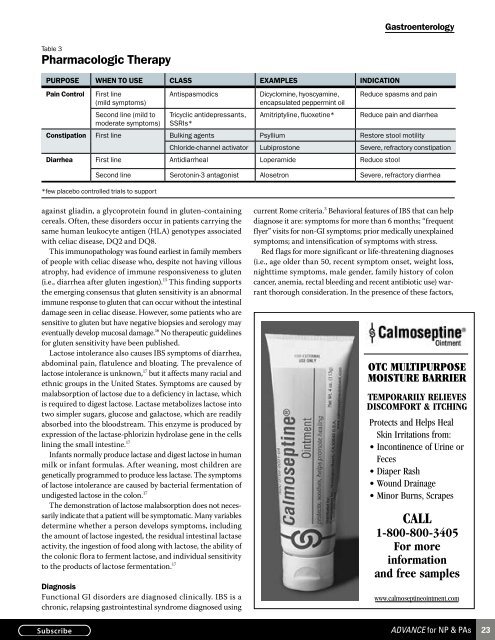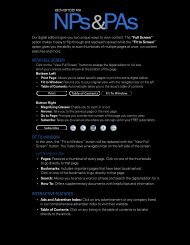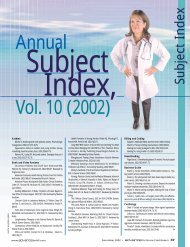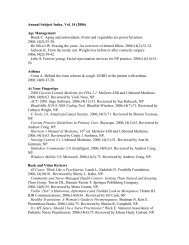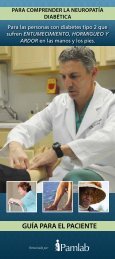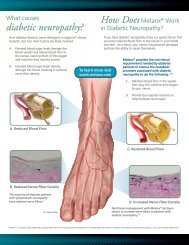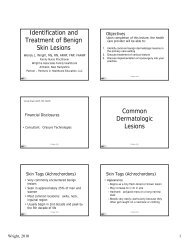View Full Screen - ADVANCE for NPs & PAs
View Full Screen - ADVANCE for NPs & PAs
View Full Screen - ADVANCE for NPs & PAs
Create successful ePaper yourself
Turn your PDF publications into a flip-book with our unique Google optimized e-Paper software.
Gastroenterology<br />
Table 3<br />
Pharmacologic Therapy<br />
Purpose When to use Class Examples Indication<br />
Pain Control<br />
First line<br />
(mild symptoms)<br />
Second line (mild to<br />
moderate symptoms)<br />
Antispasmodics<br />
Tricyclic antidepressants,<br />
SSRIs*<br />
Dicyclomine, hyoscyamine,<br />
encapsulated peppermint oil<br />
Amitriptyline, fluoxetine*<br />
Reduce spasms and pain<br />
Reduce pain and diarrhea<br />
Constipation First line Bulking agents Psyllium Restore stool motility<br />
Chloride-channel activator Lubiprostone Severe, refractory constipation<br />
Diarrhea First line Antidiarrheal Loperamide Reduce stool<br />
Second line Serotonin-3 antagonist Alosetron Severe, refractory diarrhea<br />
*few placebo controlled trials to support<br />
against gliadin, a glycoprotein found in gluten-containing<br />
cereals. Often, these disorders occur in patients carrying the<br />
same human leukocyte antigen (HLA) genotypes associated<br />
with celiac disease, DQ2 and DQ8.<br />
This immunopathology was found earliest in family members<br />
of people with celiac disease who, despite not having villous<br />
atrophy, had evidence of immune responsiveness to gluten<br />
(i.e., diarrhea after gluten ingestion). 15 This finding supports<br />
the emerging consensus that gluten sensitivity is an abnormal<br />
immune response to gluten that can occur without the intestinal<br />
damage seen in celiac disease. However, some patients who are<br />
sensitive to gluten but have negative biopsies and serology may<br />
eventually develop mucosal damage. 16 No therapeutic guidelines<br />
<strong>for</strong> gluten sensitivity have been published.<br />
Lactose intolerance also causes IBS symptoms of diarrhea,<br />
abdominal pain, flatulence and bloating. The prevalence of<br />
lactose intolerance is unknown, 17 but it affects many racial and<br />
ethnic groups in the United States. Symptoms are caused by<br />
malabsorption of lactose due to a deficiency in lactase, which<br />
is required to digest lactose. Lactase metabolizes lactose into<br />
two simpler sugars, glucose and galactose, which are readily<br />
absorbed into the bloodstream. This enzyme is produced by<br />
expression of the lactase-phlorizin hydrolase gene in the cells<br />
lining the small intestine. 17<br />
Infants normally produce lactase and digest lactose in human<br />
milk or infant <strong>for</strong>mulas. After weaning, most children are<br />
genetically programmed to produce less lactase. The symptoms<br />
of lactose intolerance are caused by bacterial fermentation of<br />
undigested lactose in the colon. 17<br />
The demonstration of lactose malabsorption does not necessarily<br />
indicate that a patient will be symptomatic. Many variables<br />
determine whether a person develops symptoms, including<br />
the amount of lactose ingested, the residual intestinal lactase<br />
activity, the ingestion of food along with lactose, the ability of<br />
the colonic flora to ferment lactose, and individual sensitivity<br />
to the products of lactose fermentation. 17<br />
Diagnosis<br />
Functional GI disorders are diagnosed clinically. IBS is a<br />
chronic, relapsing gastrointestinal syndrome diagnosed using<br />
current Rome criteria. 3 Behavioral features of IBS that can help<br />
diagnose it are: symptoms <strong>for</strong> more than 6 months; “frequent<br />
flyer” visits <strong>for</strong> non-GI symptoms; prior medically unexplained<br />
symptoms; and intensification of symptoms with stress.<br />
Red flags <strong>for</strong> more significant or life-threatening diagnoses<br />
(i.e., age older than 50, recent symptom onset, weight loss,<br />
nighttime NP010603-0008 symptoms, Calmosep.qxd male gender, 11/24/03 family history 5:12 of colon PM Page 1<br />
cancer, anemia, rectal bleeding and recent antibiotic use) warrant<br />
thorough consideration. In the presence of these factors,<br />
OTC MULTIPURPOSE<br />
MOISTURE BARRIER<br />
TEMPORARILY RELIEVES<br />
DISCOMFORT & ITCHING<br />
Protects and Helps Heal<br />
Skin Irritations from:<br />
• Incontinence of Urine or<br />
Feces<br />
• Diaper Rash<br />
• Wound Drainage<br />
• Minor Burns, Scrapes<br />
CALL<br />
1-800-800-3405<br />
For more<br />
in<strong>for</strong>mation<br />
and free samples<br />
www.calmoseptineointment.com<br />
<strong>ADVANCE</strong> <strong>for</strong> NP & <strong>PAs</strong><br />
23


